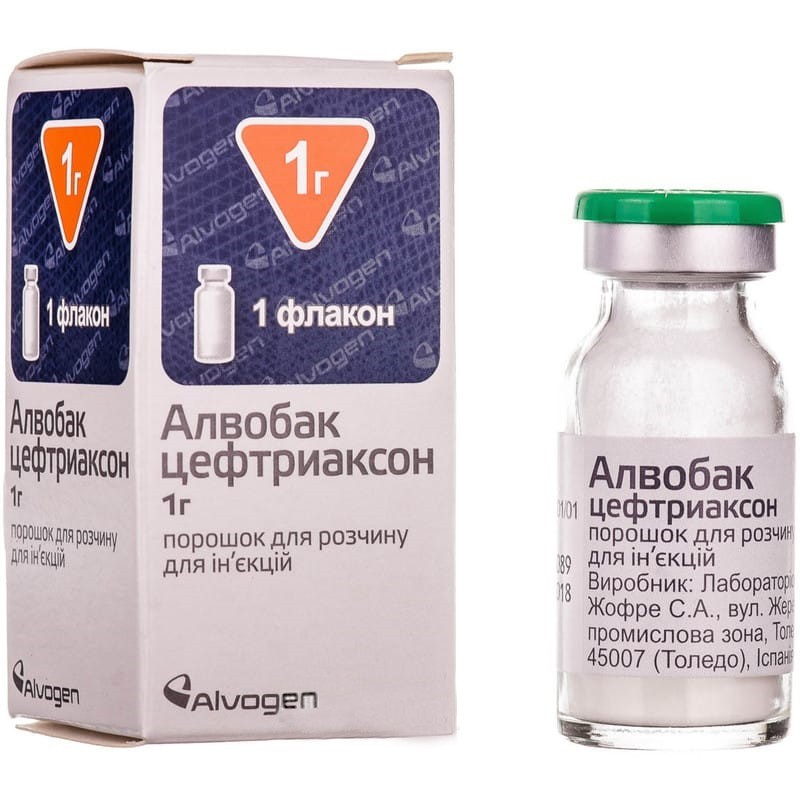



 Secure and encrypted payment processing
Secure and encrypted payment processing We ship to over 40 countries including the USA, UK, Europe, Australia and Japan
We ship to over 40 countries including the USA, UK, Europe, Australia and Japan Guaranteed refund or reship if you haven't received your order
Guaranteed refund or reship if you haven't received your orderAlvobac powder is intended for the treatment of the following infections in adults and children, including full-term newborns (from birth):
Alvobac can be used for:
Active ingredient: ceftriaxone;
1 vial contains ceftriaxone sodium equivalent to ceftriaxone - 1 g.
Hypersensitivity to ceftriaxone or to any other cephalosporin. The presence of a history of severe hypersensitivity reactions (for example, anaphylactic reactions) to any other type of beta-lactam antibacterial agents (penicillins, monobactams and carbapenems).
Ceftriaxone is contraindicated in premature infants aged ≤ 41 weeks, taking into account the term of intrauterine development (gestational age + age after birth).
Full-term newborns (aged ≤ 28 days):
Ceftriaxone solutions containing lidocaine should never be administered intravenously.
The dose of the drug depends on the severity, sensitivity, location and type of infection, as well as on the age and function of the liver and kidneys of the patient.
The following doses are generally accepted recommended for these indications. In severe cases, the highest dose should be used from the recommended range.
Adults and children over 12 years old (≥ 50 kg).
1-2 g once a day:
2 g once a day:
2-4 g once a day:
Newborns, infants and children aged 15 days to 12 years (<50 kg).
50-80 mg / kg once a day:
50-100 mg / kg (maximum - 4 g) once a day:
80-100 mg / kg (maximum - 4 g) once a day: bacterial meningitis.
100 mg / kg (maximum 4 g) once daily: bacterial endocarditis.
Newborns 0-14 days.
20-50 mg / kg once a day:
50 mg / kg once a day:
Ceftriaxone crosses the placental barrier. Limited data are available on the use of ceftriaxone in pregnant women. Animal studies do not indicate a direct or indirect harmful effect on the embryo / fetus, and postnatal development. During pregnancy, especially in the first trimester, ceftriaxone can be used only if the benefit outweighs the risk.
The safety and effectiveness of the drug Alvobac in newborns, infants and children have been established for the doses described in the section "Method of use". Studies have shown that ceftriaxone, like some other cephalosporins, can displace bilirubin from its association with serum albumin.
Alvobac is contraindicated in premature and full-term infants who are at risk of developing bilirubin encephalopathy.
During treatment with ceftriaxone, adverse reactions such as dizziness can occur, which can affect the ability to drive vehicles or work with complex mechanisms. Patients should be careful when driving or working with other mechanisms.
In case of an overdose, hemodialysis or peritoneal dialysis will not reduce excessive plasma concentrations of the drug. In case of an overdose, nausea, vomiting, diarrhea can be observed. There is no specific antidote. Overdose treatment is symptomatic.
Adverse reactions were most often observed with the use of ceftriaxone: eosinophilia, leukopenia, thrombocytopenia, diarrhea, rash and increased levels of liver enzymes.
Solvents containing calcium, such as Ringers solution or Hartmanns solution, should not be used to reconstitute Alvobac in vials or to further dilute reconstituted solution for intravenous administration, since precipitate may form. Ceftriaxone calcium salt precipitates can also be formed by mixing ceftriaxone with calcium-containing solutions in a single infusion system. Ceftriaxone cannot be administered simultaneously with intravenous solutions containing calcium, including calcium-containing solutions for long-term infusions, such as solutions for parenteral nutrition, using the Y-shaped system. However, other patients, except newborns, ceftriaxone and calcium-containing solutions can be administered sequentially, after each other, if the system is thoroughly flushed with a compatible liquid between infusions.
Store in the original packaging at a temperature not exceeding 25 ° C.
Keep out of the reach of children.
Store the prepared solution in a dark place for 6 hours at room temperature or for 24 hours at a temperature of 2-8 ° C.
Shelf life is 2 years.